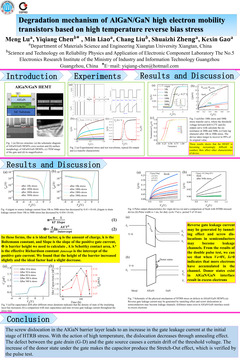Degradation mechanism of AlGaN/GaN high electron mobility transistors based on high temperature reverse bias stress
ID:146
View Protection:PUBLIC
Updated Time:2021-08-20 23:53:14
Hits:876
Poster Presentation

Start Time:Pending (Asia/Shanghai)
Duration:Pending
Session:[No Session] » [No Session Block]
Abstract
In this paper, we investigate the degradation mechanism of AlGaN/GaN high electron mobility transistors (HEMTs) under long-term high temperature reverse bias stress. For now, interface properties of metal/AlGaN structures are still not fully understood. From the viewpoint of the HEMT application, it is desirable to evaluate interface state properties using an actual AlGaN/GaN structure with a very thin AlGaN layer. Qualitative analysis of defect density based on C-V characteristics at different frequencies shows that the AlGaN surface defect density increases after HTRB stress, which may lead to depletion of 2-D electron gas (2DEG) in the channel. The defects were qualitatively compared by the double-pulse test and the gate delay characteristics, and it was found that the defects increased significantly. The experimental results show that the output characteristics of AlGaN/GaN high electron mobility transistors collapse obviously after 300 h HTRB stress, and the threshold voltage shifts forward by 0.27 V. The mechanism of increasing trap density is attributed to the defects induced by HTRB stress on AlGaN surface and AlGaN barrier layer for a long time. The experimental results may provide a useful reference for the RF application and design of AlGaN/GaN HEMT.
Keywords
Speaker







Comment submit